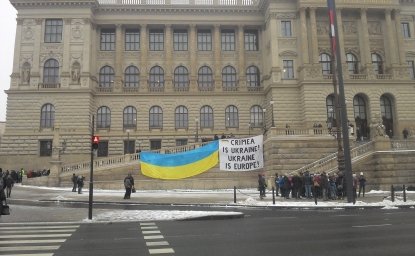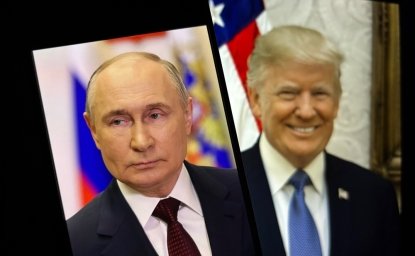European Mediators and Ukraine's Orange Revolution

"The Orange Revolution was first and foremost a Ukrainian phenomenon," said Steven Pifer, senior advisor, Russia and Eurasia Program, Center for Strategic and International Studies, and former U.S. Ambassador to Ukraine. Speaking at a 15 October 2007 Kennan Institute talk, Pifer stated that the elements of the settlement were negotiated primarily through Ukrainian channels, and that Ukrainians deserve credit for the crisis remaining peaceful. At the same time, he noted, "European mediators played an important facilitative role." Pifer described in detail the dynamics of the three roundtable discussions during the November-December 2004 crisis that helped get Ukraine out of its political impasse, and stated that the presence of European negotiators proved key to launching the negotiating process, kept pressure on the Ukrainian negotiators to make progress, and provided a strong disincentive against the use of force.
European officials took the lead in mediating the crisis, according to Pifer, and the U.S. government accepted the European lead, in part because it was seen as an appropriate issue for the European Union to manage. At the same time, U.S. diplomats maintained a "pattern of close consultations with EU officials," to share analyses of the situation in Ukraine and to ensure complementary public lines.
The three roundtable discussions, the first of which took place on November 26, just five days after the disputed second round results triggered the Orange Revolution, included the presidents of Poland and Lithuania, the EU High Representative for Common Foreign and Security Policy, the Secretary General of the Organization for Security and Cooperation in Europe, and the Chairman of the Russian Duma, in addition to the major Ukrainian participants. According to Pifer, Polish President Aleksander Kwasniewski emerged as the most influential and energetic European mediator. He enjoyed several personal advantages, including a familiarity with the political situation in Ukraine, a close personal relationship with Ukrainian President Leonid Kuchma, an ability to speak Russian in informal conversations with other roundtable participants, and the "freedom to engage" in negotiations as he was well into his second term as president. Furthermore, Kwasniewski believed that Poland had a vital interest in preventing instability "on its doorstep," an interest Kwasniewski shared with Lithuanian President Valdas Adamkus. The two worked in close cooperation throughout the negotiations.
The participation of Javier Solana, the EU High Representative for Common Foreign and Security Policy, was important to the negotiations because of his high position within the European Union, Pifer said. Although he was generally seen as more cautious than Kwasniewski, his presence brought the EU flag to the roundtable talks, something that neither Kwasniewski nor Adamkus could do. Pifer noted that Solana's more cautious engagement was explained by the need to coordinate with EU capitals (in contrast to Kwasniewski, Solana had 25 EU foreign ministries watching him) and define a mandate for his participation. Solana was also sensitive to the Russia angle and did not want a misstep in Kyiv to complicate EU-Russian relations. OSCE Secretary General Jan Kubis's participation was limited by the OSCE's diverse membership.
Russia also wanted to secure its place at the negotiating table and ultimately sent Boris Gryzlov, the Chairman of the Russian Duma. According to Pifer, the prevailing sense during the roundtables was that Gryzlov remained relatively unengaged in the negotiating process except to reiterate Russia's strong support for Viktor Yanukovych. Still, Pifer emphasized that Gryzlov's presence was important as it provided East-West balance to the mediation effort and kept Russia informed of what was going on.
Pifer said that Kwasniewski and Solana had credibility in Kyiv because of pre-existing personal relationships with Kuchma and Viktor Yushchenko. Yet, personal relationships did not suffice. Hence the importance of the involvement of the European Union, an institution that all Ukrainian roundtable participants agreed they wanted to see Ukraine join. The combination of Kwasniewski and Solana—an ad hoc arrangement—succeeded because it brought to the table known friends and the EU's institutional weight.
The roundtable discussions and Ukrainian negotiations resulted in a December 8 settlement that included a change in the composition of the discredited Central Election Commission, changes in the presidential election law for the Supreme Court-ordered rerun of the second round, and an agreement on constitutional reform. Pifer suggested similar crises may arise in the western CIS, and that the European Union could use its experience in Ukraine as a model for managing such situations in the future. This would benefit from streamlining EU mechanisms for anticipating and planning for political crises, and also delegating authority, responsibility, and resources in a way that would enable the EU High Representative to respond quickly to similar political impasses. While improving its crisis management mechanisms, Pifer suggested the European Union should also consider how to take advantage of activist member-state leaders, who might wish to engage, in order to replicate the Kwasniewski/Solana success. He concluded that the EU will remain the most important institutional actor for future mediations in the western CIS, given that other organizations such as NATO, OSCE, the Council of Europe, and the Commonwealth of Independent States are at a comparable disadvantage due to various institutional constraints.
Author

Kennan Institute
The Kennan Institute is the premier US center for advanced research on Eurasia and the oldest and largest regional program at the Woodrow Wilson International Center for Scholars. The Kennan Institute is committed to improving American understanding of Russia, Ukraine, Central Asia, the South Caucasus, and the surrounding region through research and exchange. Read more

Explore More
Browse Insights & Analysis
The OSCE is a Good Value for America

Infographic | Russia's Illegal Annexation of Crimea

Russia’s Indigenous Communities and the War in Ukraine
